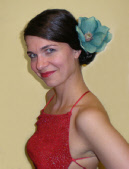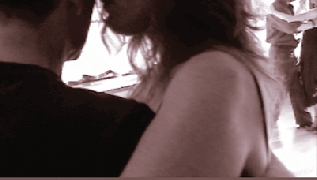
HOME
PUBLISHER’S CORNER
“A SENSORY BRIDGE TO GLOBAL CULTURE”
I was primed for this sort of in-depth processing because I was in my first year of graduate school for Dance/Movement Therapy and Counseling at Columbia College Chicago. Dance/Movement Therapy (DMT) is a psychotherapeutic tool that uses body movement as the modality for both assessment and treatment. Its premise is that outer movement reflects inner mental and emotional states, and therefore, changing movement behavior can lead to change in the psyche and spirit.1
Dance therapy emerged in the 1940s and 1950s as accomplished modern dancers came to realize the healing benefits of dance in themselves and their students. Many went on to train in traditional psychotherapy in order to deepen and substantiate their work. DMT was born out of the union of dance and psychotherapy.
The use of dance as a means of promoting health, expression, spiritual union, and integration with community is nothing new and has been a large part of primitive and traditional cultures throughout time. Unfortunately, modern life has left many people disconnected from their bodies and disconnected from others.1 DMT aims to reconnect people with their own bodies – as the body is the most direct vehicle of expression and connection to others and our environment.
As I entered the world of Argentine tango, it was evident that dance therapy was prevalent, although it was not being identified as such. I started my own journey of learning and began researching the concept of tango as a form of dance therapy. The following is what I discovered.
THE PREMISE OF DANCE/MOVEMENT THERAPY (DMT) IS THAT OUTER MOVEMENT REFLECTS INNER MENTAL AND EMOTIONAL STATES, AND THEREFORE CHANGING MOVEMENT BEHAVIOR CAN LEAD TO CHANGE IN THE PSYCHE AND SPIRIT.
̶ F.J. LEVY


Advertise in:

AS WE INAUGURATE
TANGO LIFE & NEWS
TAKE ADVANTAGE OF OUR EXCLUSIVE
ONE-TIME OFFER TO PLACE YOUR AD HERE
FREE DURING NOVEMBER!
ADVERTISERS, DON’T MISS THIS CHANCE TO FEATURE
YOUR BUSINESS IN PREMIUM WEB SPACE
THAT WILL BE SEEN BY A GLOBAL AUDIENCE!
FOR DETAILS.
312.287.8406
AS A SPECIAL INTRODUCTORY BONUS, YOU’LL ALSO RECEIVE A DISCOUNT ON ADS PLACED THROUGH JANUARY 6, 2011.


THE S P A C E BETWEEN US
PSYCHOLOGICAL PERSPECTIVES ON THE DANCE OF RELATIONSHIP


I could say that my tango journey unofficially began on a summer night in Valencia, Spain:
My Spanish lover spun me around as we danced under a full moon with the waves of the Mediterranean Sea as our soundtrack. We had only known each other for a short time, yet we moved as if we intimately knew each other’s bodies and rhythms. A part of me stood aside, witnessing the scene, laughing and thinking, this stuff only happens in movies. But there I was, participant in this profoundly romantic moment, one that only occurs a few times in a lifetime. I felt like I could melt into the sea, yet at the same time I felt as infinitely powerful as the moon above us.
“TANGO IS THE FEELING. IT IS ONE HEART AND FOUR LEGS.”
̶ JUAN CARLOS COPES
I came back at home to Chicago, my spirit clearly still floating around somewhere in that moment in Spain. Never underestimate the power of dancing with your lover on the beach; it will make ordinary life unbearable. While my heart was heavy, there was a newfound swagger in my step, a glow in my face, and an extra spark in my voice that was evident to those around me.
JOURNEY OF
THE DANCER
THE S P A C E
BETWEEN US
CONTINUES...CLICK HERE
Greta Polo earned her Masters' degree in Dance/Movement Therapy and Counseling at Columbia College Chicago. Her clinical experience involves working with adults with traumatic brain injury, refugees, and the homeless population struggling with mental illness and substance abuse. Greta also dances Argentine tango, teaches the Nia Technique, and performs and dances various other genres including modern, jazz, flamenco, hip-hop, and belly dance. She’s currently exploring tango in Buenos Aires., maybe indefinitely.
I was now a character in my own European romance, and I refused to relinquish my role because of a change in scenery. For the first time in my life, I went out and bought lacy undergarments.
Soon after my return, a friend invited me to see a band unfamiliar to me, Bajofondo Tango Club. Seductive images of tango dancers in fishnets and high heels flashed on the projector screen as the pulsing rhythms of this contemporary tango band filled the space. As I moved my body to the music with my makeshift tango moves, the lover self I had brought back from Spain was now entirely appeased. I knew in that moment – I must learn tango.
I must mention that I am a dancer. I have trained in modern, jazz, flamenco, belly dance, and hip-hop to name a few, and have extensive experience club and rave dancing. I have always danced alone and liked it that way. I enjoy my independence in general and the same rule applied to dancing. I’ve been known to dodge eye contact on the dance floor and gravitate toward corners where I can quietly indulge in my own movement.
But something changed that day on the beach when I experienced what it was like to be in sync with another human being – to feel so vulnerable and powerful at the same time, so alive and intimately connected. I started to wonder if perhaps my preference for dancing alone had less to do with independence, and more to do with protection.
Yes, I already knew the answer to this. A voice within told me that tango was going to be more than just another dance – it was going to be an inroad to some deep inner work.
I began taking tango lessons in Chicago and after a few incredible dances with strong male leads I was completely hooked. Dancing alone has its merits, but dancing a well attuned tango with a partner is comparable to flying. I became surprised and inspired by how strongly my personal tendencies of relating to the opposite sex magnified through the tango experience. It immediately required that I address some fundamental issues like trust, power, boundaries, leading and following, and most significantly, merging and separating.
